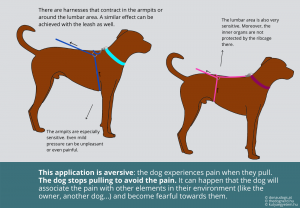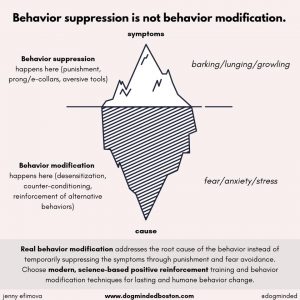DISCLAIMER
What is aversive equipment?
A stimulus is aversive when it is something that the dog will work to avoid. We define equipment as aversive when it causes discomfort or pain to the dog by design 2, in order to make them behave the way we want.
The aim of this post is to help you:
-
- understand what the problems are with aversive equipment, and
- recognize aversive equipment in the pet store.
What’s the problem with aversive equipment?
The pet care industry takes advantage of dog owners’ lack of understanding of dog behaviour on the one hand, and their expectations of easy life on the other. In the descriptions of training tools, the dogs are frequently described as „unruly” or „disobedient”, justifying the owners’ pursuit of an easy fix.
Aversive equipment is an easy fix that can negatively influence your dog’s health and psychological well-being.
But people wouldn’t buy aversive equipment, if it didn’t work
- Yes, they would. That’s what marketing is for.
- Quoting Susan Friedman3: „Effectiveness is not enough”. Just that you can threaten your child into compliance, doesn’t mean you should.
- Aversive tools work because they suppress behaviours, whereas we actually want behaviour modification.
A short note on behaviour suppression
In a nutshell, every behaviour serves a purpose and it can tell us something about the dog’s condition. Therefore, suppressing behaviour has two main consequences:
-
- you lose important information
- you may end up with something worse, since the underlying cause was not addressed
My favourite example for this is growling: dogs usually do it in order to increase distance from something that makes them uncomfortable. If you punish the growl, you can get a dog „biting out of nowhere”. Even if they stop growling in that situation, they still feel uncomfortable and want to increase the distance, but now that more subtle methods failed them, they might resort to biting.
Beware of habituation
Punishment as defined in learning theory is anything that reduces the frequency of a given behaviour. Punishment can only be effective if it is applied *just right*4 :
-
- at the right time
- with the right intensity
- it must stop the unwanted behaviour immediately
If the behavior occurs with the same frequency in the future, the intervention used was not punishment, it was an interruptor.
If you consider how many dogs pull like crazy on the leash despite wearing slip collars, it becomes clear that the equipment itself is usually not enough. What happens there is called habituation – getting used to stimuli over the course of time. It’s actually a pretty useful skill, for example if you ever moved to a busier neighbourhood habituation lets you fall asleep easily despite traffic. That also means that dogs often just get used to the aversive stimulus, and therefore the intensity of the stimulus must be continuously increased.
How can you recognize aversive equipment?
Beware of false promises
When reading product descriptions watch out for the following characteristics:
-
- the use of key words such as easy, quick, stress-free, immediate, great aid, disobedient dog, „harmless but effective”, guaranteed to deliver fast results, mimics the natural corrections given by mother dogs
- the subtext: you don’t have to train your dog, the tool does the training (for example: something teaches the dog to walk on a leash or not bark)
- the consumer comments: many people will say that „they tried out everything on the market and only this worked” – but have they tried investing time in training?
- taking agency (and responsibility) away from the owner: it’s the harness that tightens itself, the collar that administers the shock, the can that makes the startling sound5
Examine the mechanics
Especially in case of collars and harnesses it is important to examine the mechanics behind their „success”. Ask the following questions:
-
- How large is the surface area on which the tool is applied? The smaller the area, the more unpleasant/painful the force.
- Where is the tool placed? The area where neck and skull meet, the armpits or the loins are especially sensitive areas.
- What material is it made of? You can read more about it in our posts about collars and harnesses.
Conclusion
We hope that after reading this post you understand the general limitations of aversive equipment. Although some trainers consider any use of aversives unethical, others use it in special situations as a temporary management measure – that is to avoid worst case scenarios (the owner falling and injuring themselves or the dog getting loose) while the dog is in training. If a trainer frequently uses aversive equipment, consider changing the trainer. We must repeat ourselves: equipment can be useful, but it cannot replace training.
If you’re wondering how to avoid getting into trouble before your dog is trained enough, check out our tips.
If you can’t fix the problem on your own, find a professional trainer or behaviourist and make sure they have valid credentials (such as university education, proof of ongoing education, membership in professional organizations).
In Eileen’s post you can find a list of scientific studies that looked into the fallout of using aversive training methods (such as avoidance behaviours, generalized anxiety, aggression, learned helplessness).
Don’t miss any new posts, follow The Dog Nerd on facebook!
Check out my other equipment posts
How to choose the right collar for your dog
How to choose the perfect harness for your dog
How to choose the perfect leash for you and your dog
How to choose the perfect muzzle for your dog
Help, my dog pulls on the leash!
These posts were created in collaboration with Donau Dogs.
- Please refer to the bottom of this post.
- Of course any object can be used aversively but this is not the main topic of this post.
- Susan Friedman is an internationally acclaimed expert in behaviour science.
- We’re not advocating for using it at all, again, “effectiveness is not enough”.
- By the way, dogs are very good with context and there is no guarantee that they won’t link the tool to their owner.



